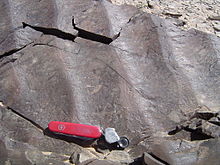
A paleocurrent or paleocurrent indicator is a geological feature (typically a sedimentary structure) that helps one determine the direction of flowing water in the geologic past. This is an invaluable tool in the reconstruction of ancient depositional environments.[1]
There are two main types of paleocurrent indicators:
- Unidirectional, which give a clear, single direction of flow
- Bidirectional, which give a good linear direction, but it is unclear which direction along the linear trend the water flowed.
Paleocurrents are usually measured with an azimuth, or as a rake on a bedding plane, and displayed with a Rose Diagram to show the dominant direction(s) of flow. This is needed because in some depositional environments, like meandering rivers, the paleocurrent resulting from natural sinuosity has a natural variation of 180 degrees or more.[2]
Below are a partial list of common paleocurrent indicators:
- ^ Prothero, D. R. and Schwab, F., 1996, Sedimentary Geology, pg. 48–51, ISBN 0-7167-2726-9
- ^ Miaoa, Xiaodong; Huayu Lua; Zhen Lid; Guangchao Caod (July 2008). "Paleocurrent and fabric analyses of the imbricated fluvial gravel deposits in Huangshui Valley, the northeastern Tibetan Plateau, China". Geomorphology. 99 (1–4). © 2007 Elsevier B.V.: 433–442. Bibcode:2008Geomo..99..433M. doi:10.1016/j.geomorph.2007.12.005.
